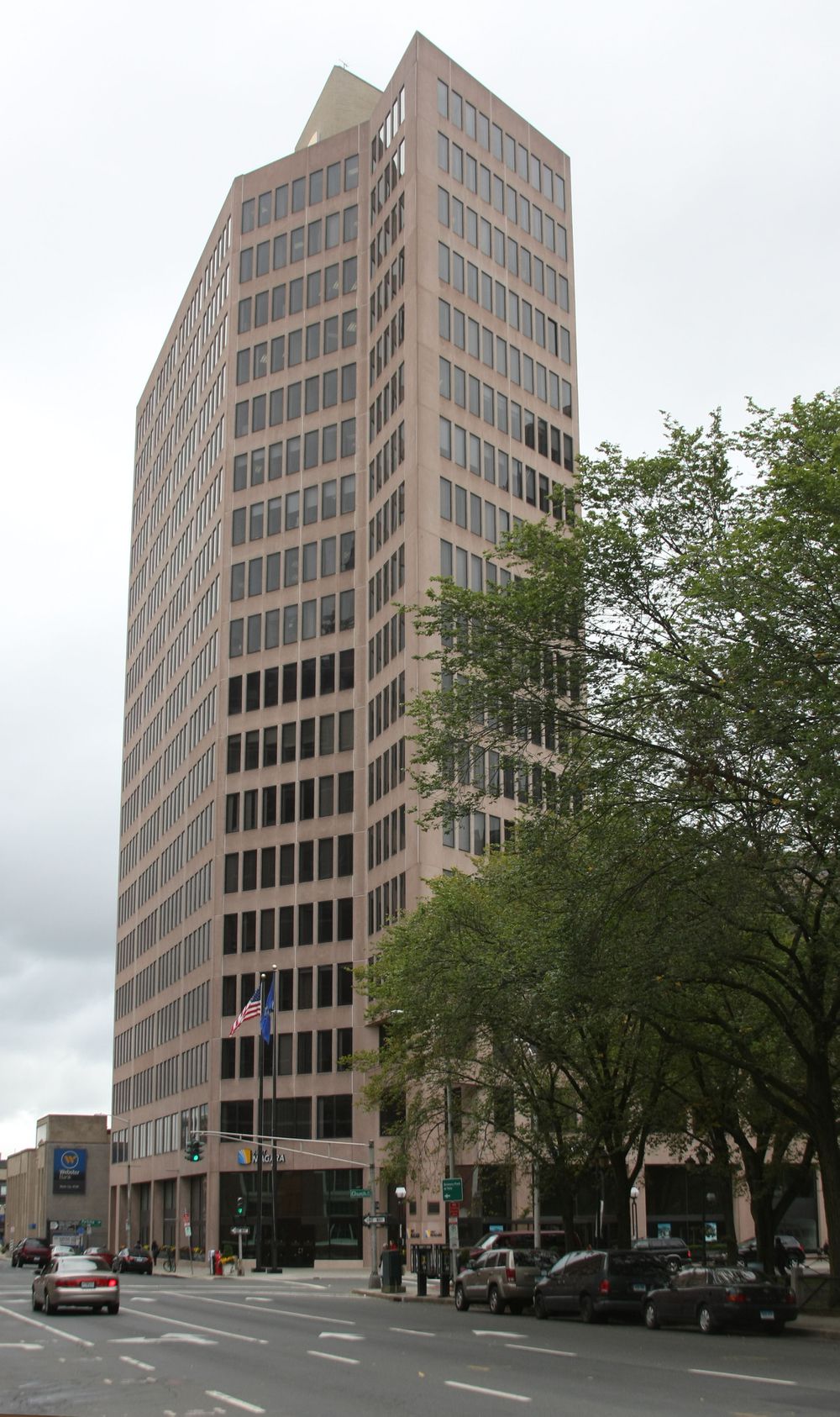
195 Church Street, New Haven, CT
The New Haven Savings Bank Building on the corner of Elm and Church Street is a formidable structure at the heart of downtown New Haven. While local New Havenites may not say it is attractive, they will admit that “it is recognizable” with its eighteen-story limestone façade cutting sharp angles and its clean modernist lines. Based upon architect William Pederson’s design, and erected in 1972 by the Dwight Building Company for the New Haven Savings Bank, the building clearly reflects the era’s desire to recreate the downtown as a clean modern city. An advertising pamphlet from its opening plainly reveals this agenda, as its attempts to entice potential tenants “…poised with landmark proportions across from the historic New Haven Green, at the hub of a thriving community, the New Haven Savings Bank Building Reflects the spirit of Progress which is the city’s New England heritage.” It goes on to say, a “symbol of the dramatic upsurge of downtown New Haven, and of the limitless growth of the East Coast business community, One Ninety Five Church Street is a most distinguished address.” Furthermore, it boasted the most modern technologies of the time, such as modern climate control, and high-speed, computerized elevators. While three of its floors were meant to house the New Haven Savings Bank (now First Niagara Bank), the rest were intended for leasing and have been filled by a variety of industry’s, including lawyers, accountants, and real estate agents. While the corner of Elm and Church Streets has long been a hub of the city, it has not always been a thriving business center. A map from 1641 indicates that the plot of land belonged to an elder of the town, and neighbored the reverend John Davenport. Though the corner already housed notables of the society, in 1641 the square was purely residential. However, by 1742 the White Haven Society, a break-away from Center Church, had built their “Blue Meeting House,” and are the derivation of the name Church Street. While their numbers eventually dwindled under the dry words of Jonathan Edwards, by 1824 the land had been left as a parsonage lot. However, by 1845 inventor and rubber manufacturer Charles Goodyear inhabited one of the four row houses, known as St. John’s Place, that had been built on the site. Then by 1869, a larger row known as The Sheffield Block had been erected around the corner on Elm Street. These new structures represented the changes of the city and the growing density of the downtown. With the city growing it is little surprise that, sometime between 1901 and 1911, St. John’s Place had been turned into a primarily commercial building and then again by 1916 had been razed to make room for the Colonial Building. The Colonial Building was a commercial, five-story building that housed a brokerage firm, Gilberts Restaurant, and a series of professional offices in the upper floors. Then around the corner the Sheffield had experienced similar, albeit less dramatic, change as a series of small restaurants were tacked to its façades. Physically the corner remained largely unaltered until the 1970s, although it seems that it suffered the same economic depression that much of the rest of downtown New Haven suffered during this era. And by the early 1970s part of the corner had made its way into the hands of the Redevelopment Agency. In 1972 the entire corner was cleared to make way for the New Haven Savings Bank Building that stands there today. The erecting of the new building was a feat appropriate to the times, as a Silkorsky helicopter carried 132,000 pounds of air conditioning and heating equipment to its roof. And while the building clearly speaks to the ideals of another era, it is still relevant today as it continues to be occupied and well kept up. Also, while the corner is no longer composed of small restaurants with offices above, the building does offer a restaurant, a newsstand, and gym facilities within. Today, the building is home primarily to law firms and real estate offices, all though other groups such as the Arts Council of Greater New Haven can be found there as well.
First Niagara Bank
Researcher
Django Broer-Hellermann
Date Researched
Entry Created
June 4, 2017 at 8:47 AM EST
Last Updated
July 1, 2025 at 5:57 PM EST by karinaencarnacion
Historic Name
New Haven Savings Bank Building
Style
ModernistPostmodernCurrent Use
CommercialCoffee/Tea/Ice Cream/YogurtOffices / Business ActivitiesEra
1950-1980Neighborhood
OtherTours
Business and Commerce east of the GreenYear Built
1973
Architect
William Pederson
Current Tenant
Fepo Cafe, Adelman Law Office, Levy Leff and DeFrank PC
Roof Types
FlatStructural Conditions
Good
Street Visibilities
Visible from the street
Threats
None knownExternal Conditions
Good
Dimensions
18 stories + basement; 5 stories + basement; 230' x 110'
Street Visibilities
Visible from the street
Owner
Ownernishp Type
Private
Client
New Haven Savings Bank
Historic Uses
CommercialRestaurantBank






Comments
You are not logged in! Please log in to comment.